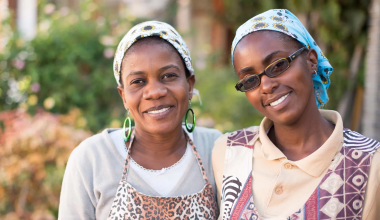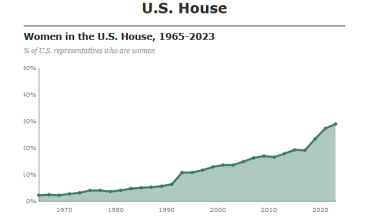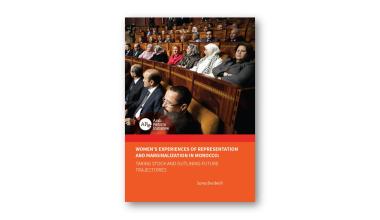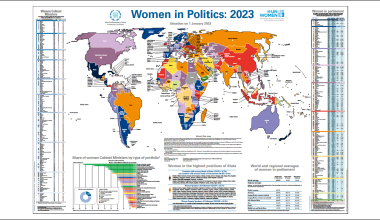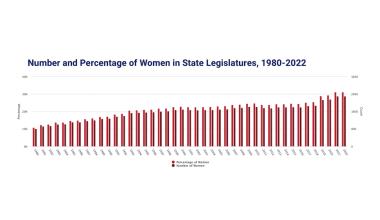Parliaments & Representatives
Main navigation
A Glimpse into the Life of a Women in Politics: CEMR Unveils First Data Coming from 31 Countries
The Council of European Municipalities and Regions (CEMR) has released the first infographics showcasing critical insights from their latest report, "Women in Politics."
The data offer a visual snapshot of the representation of women in elected roles across various subnational levels. Additionally, a detailed breakdown of their portfolios at the local level is provided. The second slide of the infographics unveils the results of an anonymous CEMR survey involving 2,424 participants from 31 countries. Focused on elected women in local and regional European roles, the survey explores their experiences of violence in the political realm.
Click here to see the infographic published by the Council of European Municipalities and Regions on 14 December 2023.
Normal
0
false
false
false
EN-US
X-NONE
X-NONE
DefSemiHidden="false" DefQFormat="false" DefPriority="99"
LatentStyleCount="376">
UnhideWhenUsed="true" QFormat="true" Name="heading 2"/>
UnhideWhenUsed="true" QFormat="true" Name="heading 3"/>
UnhideWhenUsed="true" QFormat="true" Name="heading 4"/>
UnhideWhenUsed="true" QFormat="true" Name="heading 5"/>
UnhideWhenUsed="true" QFormat="true" Name="heading 6"/>
UnhideWhenUsed="true" QFormat="true" Name="heading 7"/>
UnhideWhenUsed="true" QFormat="true" Name="heading 8"/>
UnhideWhenUsed="true" QFormat="true" Name="heading 9"/>
Name="index 1"/>
Name="index 2"/>
Name="index 3"/>
Name="index 4"/>
Name="index 5"/>
Name="index 6"/>
Name="index 7"/>
Name="index 8"/>
Name="index 9"/>
UnhideWhenUsed="true" Name="toc 1"/>
UnhideWhenUsed="true" Name="toc 2"/>
UnhideWhenUsed="true" Name="toc 3"/>
UnhideWhenUsed="true" Name="toc 4"/>
UnhideWhenUsed="true" Name="toc 5"/>
UnhideWhenUsed="true" Name="toc 6"/>
UnhideWhenUsed="true" Name="toc 7"/>
UnhideWhenUsed="true" Name="toc 8"/>
UnhideWhenUsed="true" Name="toc 9"/>
Name="Normal Indent"/>
Name="footnote text"/>
Name="annotation text"/>
Name="header"/>
Name="footer"/>
Name="index heading"/>
UnhideWhenUsed="true" QFormat="true" Name="caption"/>
Name="table of figures"/>
Name="envelope address"/>
Name="envelope return"/>
Name="footnote reference"/>
Name="annotation reference"/>
Name="line number"/>
Name="page number"/>
Name="endnote reference"/>
Name="endnote text"/>
Name="table of authorities"/>
Name="macro"/>
Name="toa heading"/>
Name="List"/>
Name="List Bullet"/>
Name="List Number"/>
Name="List 2"/>
Name="List 3"/>
Name="List 4"/>
Name="List 5"/>
Name="List Bullet 2"/>
Name="List Bullet 3"/>
Name="List Bullet 4"/>
Name="List Bullet 5"/>
Name="List Number 2"/>
Name="List Number 3"/>
Name="List Number 4"/>
Name="List Number 5"/>
Name="Closing"/>
Name="Signature"/>
UnhideWhenUsed="true" Name="Default Paragraph Font"/>
Name="Body Text"/>
Name="Body Text Indent"/>
Name="List Continue"/>
Name="List Continue 2"/>
Name="List Continue 3"/>
Name="List Continue 4"/>
Name="List Continue 5"/>
Name="Message Header"/>
Name="Salutation"/>
Name="Date"/>
Name="Body Text First Indent"/>
Name="Body Text First Indent 2"/>
Name="Note Heading"/>
Name="Body Text 2"/>
Name="Body Text 3"/>
Name="Body Text Indent 2"/>
Name="Body Text Indent 3"/>
Name="Block Text"/>
Name="Hyperlink"/>
Name="FollowedHyperlink"/>
Name="Document Map"/>
Name="Plain Text"/>
Name="E-mail Signature"/>
Name="HTML Top of Form"/>
Name="HTML Bottom of Form"/>
Name="Normal (Web)"/>
Name="HTML Acronym"/>
Name="HTML Address"/>
Name="HTML Cite"/>
Name="HTML Code"/>
Name="HTML Definition"/>
Name="HTML Keyboard"/>
Name="HTML Preformatted"/>
Name="HTML Sample"/>
Name="HTML Typewriter"/>
Name="HTML Variable"/>
Name="Normal Table"/>
Name="annotation subject"/>
Name="No List"/>
Name="Outline List 1"/>
Name="Outline List 2"/>
Name="Outline List 3"/>
Name="Table Simple 1"/>
Name="Table Simple 2"/>
Name="Table Simple 3"/>
Name="Table Classic 1"/>
Name="Table Classic 2"/>
Name="Table Classic 3"/>
Name="Table Classic 4"/>
Name="Table Colorful 1"/>
Name="Table Colorful 2"/>
Name="Table Colorful 3"/>
Name="Table Columns 1"/>
Name="Table Columns 2"/>
Name="Table Columns 3"/>
Name="Table Columns 4"/>
Name="Table Columns 5"/>
Name="Table Grid 1"/>
Name="Table Grid 2"/>
Name="Table Grid 3"/>
Name="Table Grid 4"/>
Name="Table Grid 5"/>
Name="Table Grid 6"/>
Name="Table Grid 7"/>
Name="Table Grid 8"/>
Name="Table List 1"/>
Name="Table List 2"/>
Name="Table List 3"/>
Name="Table List 4"/>
Name="Table List 5"/>
Name="Table List 6"/>
Name="Table List 7"/>
Name="Table List 8"/>
Name="Table 3D effects 1"/>
Name="Table 3D effects 2"/>
Name="Table 3D effects 3"/>
Name="Table Contemporary"/>
Name="Table Elegant"/>
Name="Table Professional"/>
Name="Table Subtle 1"/>
Name="Table Subtle 2"/>
Name="Table Web 1"/>
Name="Table Web 2"/>
Name="Table Web 3"/>
Name="Balloon Text"/>
Name="Table Theme"/>
Name="List Paragraph"/>
Name="Intense Quote"/>
Name="Subtle Emphasis"/>
Name="Intense Emphasis"/>
Name="Subtle Reference"/>
Name="Intense Reference"/>
UnhideWhenUsed="true" Name="Bibliography"/>
UnhideWhenUsed="true" QFormat="true" Name="TOC Heading"/>
Name="Grid Table 1 Light Accent 1"/>
Name="Grid Table 6 Colorful Accent 1"/>
Name="Grid Table 7 Colorful Accent 1"/>
Name="Grid Table 1 Light Accent 2"/>
Name="Grid Table 6 Colorful Accent 2"/>
Name="Grid Table 7 Colorful Accent 2"/>
Name="Grid Table 1 Light Accent 3"/>
Name="Grid Table 6 Colorful Accent 3"/>
Name="Grid Table 7 Colorful Accent 3"/>
Name="Grid Table 1 Light Accent 4"/>
Name="Grid Table 6 Colorful Accent 4"/>
Name="Grid Table 7 Colorful Accent 4"/>
Name="Grid Table 1 Light Accent 5"/>
Name="Grid Table 6 Colorful Accent 5"/>
Name="Grid Table 7 Colorful Accent 5"/>
Name="Grid Table 1 Light Accent 6"/>
Name="Grid Table 6 Colorful Accent 6"/>
Name="Grid Table 7 Colorful Accent 6"/>
Name="List Table 1 Light Accent 1"/>
Name="List Table 6 Colorful Accent 1"/>
Name="List Table 7 Colorful Accent 1"/>
Name="List Table 1 Light Accent 2"/>
Name="List Table 6 Colorful Accent 2"/>
Name="List Table 7 Colorful Accent 2"/>
Name="List Table 1 Light Accent 3"/>
Name="List Table 6 Colorful Accent 3"/>
Name="List Table 7 Colorful Accent 3"/>
Name="List Table 1 Light Accent 4"/>
Name="List Table 6 Colorful Accent 4"/>
Name="List Table 7 Colorful Accent 4"/>
Name="List Table 1 Light Accent 5"/>
Name="List Table 6 Colorful Accent 5"/>
Name="List Table 7 Colorful Accent 5"/>
Name="List Table 1 Light Accent 6"/>
Name="List Table 6 Colorful Accent 6"/>
Name="List Table 7 Colorful Accent 6"/>
Name="Mention"/>
Name="Smart Hyperlink"/>
Name="Hashtag"/>
Name="Unresolved Mention"/>
Name="Smart Link"/>
/* Style Definitions */
table.MsoNormalTable
{mso-style-name:"Table Normal";
mso-tstyle-rowband-size:0;
mso-tstyle-colband-size:0;
mso-style-noshow:yes;
mso-style-priority:99;
mso-style-parent:"";
mso-padding-alt:0in 5.4pt 0in 5.4pt;
mso-para-margin-top:0in;
mso-para-margin-right:0in;
mso-para-margin-bottom:8.0pt;
mso-para-margin-left:0in;
line-height:107%;
mso-pagination:widow-orphan;
font-size:11.0pt;
font-family:"Calibri",sans-serif;
mso-ascii-font-family:Calibri;
mso-ascii-theme-font:minor-latin;
mso-hansi-font-family:Calibri;
mso-hansi-theme-font:minor-latin;
mso-bidi-font-family:"Times New Roman";
mso-bidi-theme-font:minor-bidi;
mso-font-kerning:1.0pt;
mso-ligatures:standardcontextual;}
Women are not only underrepresented as political candidates across the country, they're also underrepresented as donors.
Driving the news: Women donors made up just 29% to 33% of the contributions to general election candidates at statewide and state legislative levels between 2019 and 2022.
That's according to a new report on the "donor gap" from Rutgers' Center for American Women and Politics using data from OpenSecrets.
Click here to read the full article published by Axios on 17 October 2023.
How is the world doing on gender equality? According to the World Economic Forum (WEF), the picture is mixed. The needle is moving in the right direction, according to its latest Global Gender Gap report, but incrementally. At the current rate of progress, the report finds, it will take 131 years to reach full parity. And no country has yet achieved full gender equality.
Click here to read the full article published by the BBC News on 28 September 2023.
As women’s representation in U.S. politics has grown, 53% of Americans say there are still too few women in high political office in the United States, and many see significant obstacles for women candidates. Our 2023 report on women leaders in politics explores Americans’ views about gender and political leadership, as well as views about the barriers women face.
Click here to read the full article published by the Pew Research Center on 27 September 2023.
In both politics and public life in the UK, women have historically been underrepresented. In recent years women’s representation has increased, although in most cases men remain overrepresented, especially in more senior positions.
This briefing presents statistics on a range of positions in UK politics and public life held by women. Data on the demographic characteristics of different workforces tends to be limited, so it is not always possible to include intersectional analysis, for example, on disabled women or women from minority ethnic groups.
Click here to access the report.
Introduction
The trajectories of and challenges to women’s political participation in Morocco are complex. This complexity can be better understood by unpacking three dimensions for the analysis: the legal reforms, party structures, and women’s individual experiences.
Since the 2002 legislative elections, the antinomic evolution of women's political participation in Morocco has challenged researchers in the political field. We speak of antinomy in the sense that this observation is recorded at the numerical level and is accompanied by a decline in the effective representation of women in decision-making positions. The different governments that have alternated over Morocco since have introduced a series of reforms and measures aiming at encouraging women's political participation, notably the integration of the principle of positive discrimination, better known as the quota system.
Click here to read the paper published by the Arab Reform Initiative on 6 April 2023.
The “Women in politics: 2023” map, created by the Inter-Parliamentary Union (IPU) and UN Women, presents new data for women in executive positions and national parliaments as of 1 January 2023. Data show that women are underrepresented at all levels of decision-making worldwide and that achieving gender parity in political life is far off.
Women serve as Heads of State and/or Government in only 31 countries. Women make up 26.5 per cent of Members of Parliament. Globally, less than one in four Cabinet Ministers is a woman (22.8 per cent). New data show that women lead important human rights, gender equality, and social protection policy portfolios, while men dominate policy areas like defence and economy.
Source: UN Women
In the 2020 elections in Georgia, women increased their share of seats in parliament from 14 to almost 20 percent.
This was the highest it had ever been. But it is not enough, say two MPs, Ana Natsvlishvili from the opposition party, Lelo, and Nino Tsilosani from the ruling party, Georgian Dream.
Both women acknowledge the role of gender quotas, introduced in the last parliamentary (2020) and local elections (2021), in breaking the decades-long underrepresentation of women. “If it wasn’t for gender quotas, political parties would not have put talented and competent women on electoral lists,” says Natsvlishvili.
Tsilosani says women’s political participation is linked to their economic empowerment. “Sixty percent of Georgian women are left outside the formal labour market. This means that they are neither employed nor looking for a job. Imagine what a gain it would be for the economy if we could get them to employment and economic activity. We must offer women services and support to help them become active and contribute to the country’s economic growth.”
Click here to read the full article published by UNDP on 29 June 2022.
Number and Percentage of Women in State Legislatures, 1980-2022
[[{"fid":"20338","view_mode":"media_original","fields":{"format":"media_original","field_file_image_alt_text[und][0][value]":"Number and Percentage of Women in State Legislatures, 1980-2022","field_file_image_title_text[und][0][value]":"Number and Percentage of Women in State Legislatures, 1980-2022"},"link_text":null,"type":"media","field_deltas":{"2":{"format":"media_original","field_file_image_alt_text[und][0][value]":"Number and Percentage of Women in State Legislatures, 1980-2022","field_file_image_title_text[und][0][value]":"Number and Percentage of Women in State Legislatures, 1980-2022"}},"attributes":{"alt":"Number and Percentage of Women in State Legislatures, 1980-2022","title":"Number and Percentage of Women in State Legislatures, 1980-2022","class":"media-element file-media-original","data-delta":"2"}}]]
Current State Legislature
2,300
(1,516D, 764R, 13NP, 5Ind, 2Prg)
31.2% of 7,383 seats
Since 1971, the number of women serving in state legislatures has more than quintupled.
NP = non-partisan, Ind = Independent, Prg = Progressive
State-by-State Summary Data on Current Women State Legislators
Click here to access the data.
How does the gender composition of the Australian parliament compare with parliaments around the world, and how has it changed over the past two decades
International comparisons
The Inter-Parliamentary Union (IPU) has published international rankings of women in national parliaments since 1997. The IPU’s rankings are based on the representation of women in the lower (or single) houses of national parliaments only. The representation of women in the Australian Senate is therefore not factored into Australia’s ranking.
As illustrated in Figure 1 below, Australia’s IPU ranking for women in national parliaments was 27th in 1997, rising to 15th in 1999. In 2022 Australia’s ranking has fallen to 57th.
Click here to read the full article published by Parliament of Australia on 20 April 2022.
Data provided by the Center for American Women and Politics and KnowWho Data Services. Numbers include members and officers of the municipal legislative branch of incorporated cities and towns with populations over 10,000 as per the U.S. Census. These bodies vary by municipality, but include city councils, boards of alderman, city commissions, among others. Mayors and other officials who perform mayoral functions are included in these counts. Data is as of March 2022 and will be updated annually.
Click here to access the data.
A survey on politicians in Japan has shown that many former and current female national legislators and local assembly members have been subject to sexual harassment.
"I was threatened that if I did not kiss them, they would not vote for me," and "I was told that young women win elections even if they are not qualified," are examples of some of the responses.
Released in February, the results were a part of a "politician harassment white paper" containing the results of a survey carried out by Tokyo-based Woman Shift, a network of young female lawmakers and assembly members, as well as Polilion, a Gifu Prefecture-based organization that conducts harassment training for legislatures and assemblies. The survey was carried out between August and October 2021, and 200 people (100 men, 98 women and 2 others) responded.
Click here to read the full article published by The Mainichi on 29 March 2022.


